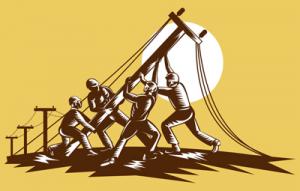Connecting Before the Storm

In the wake of Superstorm Sandy, utilities are already facing huge pressure to create smarter energy delivery and stronger infrastructure, all while keeping prices down.
But as Rahm Emmanuel famously said four years ago in the wake of the financial superstorm, “you never want a serious crisis to go to waste.” It’s important for utilities to understand that the extreme weather last fall not only underscores the need for operational improvements, it also introduces profound implications for how utilities communicate.
This goes way beyond the concept that utilities must communicate better during storms. This is about changing the way they communicate long after power is restored and the visible work ends. It’s about a new language – a comprehensive shift in how and when utilities reach customers, the words they use, and the way they frame the conversation. It’s an opportunity that utilities should embrace.
The need for this shift stems from the fact that customers don’t value the work utilities do each day. They take it for granted because energy is by nature a behind-the-scenes business. This is an industry of engineers who solve problems and don’t boast.
When everything is running smoothly most utilities see no need to communicate. The lights go on, and customers don’t think much about how or why. But that’s changing with violent weather. Everyone thinks about their electricity when a major storm knocks it out. Everyone asks questions. And in response utilities are playing catch-up to rebuild a positive dialogue with customers.
These same customers who ask the tough questions when their power is out don’t think of all the proactive work the industry does to keep homes, schools and hospitals up and running during normal weather. This is because no one is telling them about it. Utilities need to tell that story to regain public support and boost their perceived value. And they need a new language to tell it.
So how should utilities define this new language? While each utility is unique, the new language should embrace three principals: it should be active, consistent and positive.
Active Engagement
Active means establishing a deeper dialogue. Many utilities have started doing this through efficiency tips and tools. This type of proactive outreach must extend to the actual work utilities do every day. It must signal to customers that for utilities, the work never stops. As an example, utilities should highlight the role they’re taking in researching innovative ways to improve a community’s power supply.
In times of crisis, active means anticipating instead of responding. After a storm the papers flood with stories of customer complaints and angry mayors. And utilities mostly react. This dynamic must change to one where utilities actively push solutions and engage communities before their leaders come calling. An active position tells customers that their utility doesn’t just pop up each time a power line goes down or rates need adjustment. If nothing else, customers should know this: their utility is dedicated to helping protect the people of the towns and cities in its territory.
Consistent Messaging
Consistent means a steady drumbeat. It also means a lexicon that’s understood and embraced by the entire organization.
This is critical for utilities that hope to break through the clutter. Because most regulated utilities have tight marketing budgets, they’ll never be able to reach consumers like a major marketer. So they must build a positive foundation. They must prime the conversation because when disaster strikes, customers will search the Internet for information about it, talk to their friends and family, and vent on social networks. And if a utility hasn’t laid the groundwork, the conversation will be entirely defined on customers’ terms.
To lay the foundation, all utility personnel must deliver the same message – from linemen, to customer service reps, to the CEO. It’s not easy, but it gives utilities a fighting chance.
Positive Future
Finally, it’s about staying positive. In the context of violent weather, positive really means focusing on the future. Utilities can’t rest on their laurels. Customers want to hear visions for the future and what a utility is doing every day to make it happen. This is tough because many times the natural gaze of a utility is backwards. Rate cases are almost always about recovery costs, based on earlier test periods. Regardless, utilities have to find future-focused messages that people can get behind and deliver.
When customers ask “what happened?” utilities must remember that they’re actually asking “what will you do about it?” And only when customers feel their utility is charting a better, more positive path to the future will they believe that utility is a competent manager of the energy they need to run their lives.
Changing utility communication habits won’t be easy. Utility executives are a heads-down, hard-working crew. But if utilities are going to continue to operate as is, change needs to occur on many fronts. One of the most essential changes, and possibly the easiest one to make, is how they communicate.
ABOUT THE AUTHORS: Thayer Fox and Patrick Buckley are vice presidents at maslansky + partners, a public opinion and messaging strategy firm in New York.



